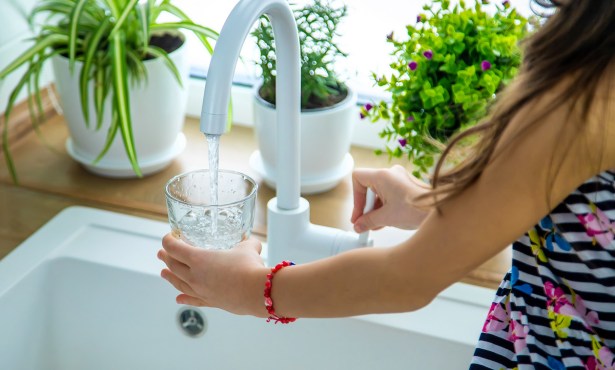California’s Drought Sparks Innovation in Santa Barbara County
Hope Ranch’s Water Supplier Floats Idea of Offshore Desal
Dry times call for innovative measures, and with California facing its driest year in nearly a century, the privately held water company that supplies Santa Barbara’s Hope Ranch community is floating a unique idea. La Cumbre Mutual Water Company, the affluent community’s supplier, is considering purchasing water produced by an offshore desalination plant contained within a buoy being designed by Ecomerit Technologies.

Called the SeaWell Buoy, each unit could produce as much as 950 acre-feet per year, enough to supply 5,000 homes, and be able to sell it at competitive rates, said Peter Stricker of Ecomerit. The buoys, which would cost roughly $2 million-$4 million to produce, would lie six feet above the water, be about 15 feet in diameter, and have a 40-foot submerged reverse osmosis plant.
Stricker is working with Jim Dehlsen, who founded Clipper Windpower, an early wind turbine company in Carpinteria. Their background in green technologies powers a larger plan for the desal buoy, which includes a slow seawater intake to avoid harming sea life, dispersed brine disposal, marine-based power generation or land-based micro-grid, and material that resists salt corrosion.
It could be a couple of years before they got through the required permitting, Stricker acknowledged. But with 17 million people living in coastal counties and the whiplash weather effects of climate change, “it could solve water problems here in Santa Barbara County,” Stricker said, “and water being delivered now could instead be used in the Central Valley for agriculture or other areas without coastal access.”
Stricker had been involved in Clipper with Dehlsen two decades ago. “When wind energy started, it was all centralized power plants. No one took it seriously,” he said. “Now it’s the cheapest form of energy out there, sustainable, all those good things. The state could benefit from rethinking the water supply.”
The need for such radical rethinking underscores just how critical the state’s water woes have become. Currently, all 58 counties that make up California are under drought disaster declarations by the U.S. Department of Agriculture, which recently opened USDA grants for crops, livestock, honeybees, and emergency watershed protection and reforestation programs. Santa Barbara County was dry during the 2021 water year — which runs from September 1 to August 31 — measuring a low of 4 inches in Carpinteria to a high of 14 inches at San Marcos Pass, or 48 percent of normal overall. Though Governor Gavin Newsom asked for voluntary conservation of 15 percent in July, that request has not been passed along to Goleta or Santa Barbara water customers.
Sign up for Indy Today to receive fresh news from Independent.com, in your inbox, every morning.
Fully 87 percent of the state is in either exceptional or extreme drought conditions, having averaged barely a foot of rain last year, the driest year on record since 1924. The largest reservoir in California, Shasta up near Redding, is at critically low levels, and its second largest, Oroville on the Feather River, has gone from a crisis-level spill in 2017 to a record low this year.

Santa Barbara County’s water agencies pull their state water from San Luis Reservoir in Merced County, which resembles a prairie at its current 10 percent capacity. The reservoir, which has no natural streams or springs, customarily goes dry at the end of the water year and is filled by water project pipes to hold downstream customers’ allocations of water.
“It’s like the Central Bank of water,” said Josh Haggmark, head of water resources for the City of Santa Barbara. “It’s a completely manmade storage device,” but it figures into the health of water sources like the San Joaquin Delta in the long run. If there’s inadequate Sierra snowmelt to feed Northern California’s rivers and aquifers, less water is likely to be allocated to Southern California and be held in San Luis.
Haggmark wasn’t too worried. He said Santa Barbara has about three years’ worth of water banked in Lake Cachuma, a savings mainly from the city’s desal plant, which creates more than 3,000 acre-feet of water. City water customers use about 10,000 acre-feet per year, and their conservation rate is 25 percent, said Haggmark. He was peeved the governor had changed the conservation baseline year from 2013 to 2020, but he saw no need to ask the city’s customers for further conservation — yet. A very dry winter could change that.
Similarly, Goleta Water District considered its mix of Cachuma, state, ground, and recycled water would meet all needs through spring 2023. The district’s customers were among the most conservation-minded in the state, said David Matson, assistant general manager, and had already adopted drier gardens and appliances.
While both Matson and Haggmark welcomed a rainy winter, Haggmark noted that climate change was generating more extremes. “We can go from drought to a flood year pretty quickly,” he said. An El Niño or La Niña year used to mean something when the atmosphere was more stable, but “we don’t have models that know what to do with climate change right now.”
Support the Santa Barbara Independent through a long-term or a single contribution.




You must be logged in to post a comment.